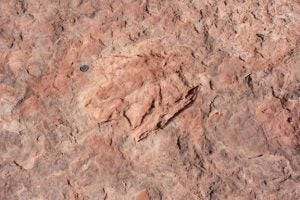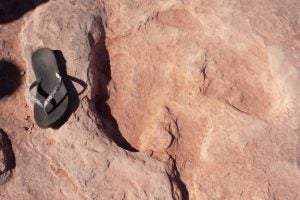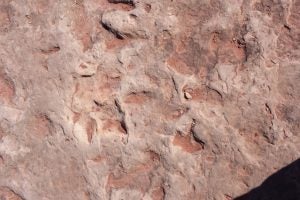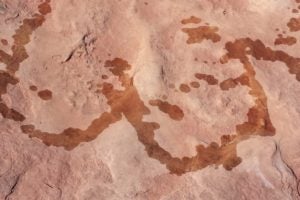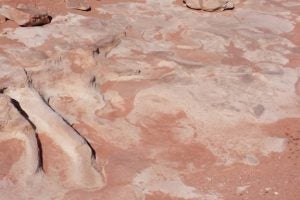Cameron Dinosaur Trackway, and the Moenave Formation
by Neil Redmond and Ryan Shell
Background
The Early Jurassic aged Moenave Formation is a layer that sits upon the Triassic Chinle Formation. It is part of a group of Mesozoic rocks that make up the southern Colorado Plateau. Part of the Glen Canyon Group, the Moenave Formation is exposed in the Four Corners Region within Arizona and Utah. This layer is important to geologists because it preserves hundreds of dinosaur footprints assigned to the ichnogenus Grallator (some papers refer to this group as Eubrontes). These impressions are best preserved in the area outside of Tuba City, AZ inside of the Navajo Reservation. The sedimentary structures preserved by the Moenave Formation have been interpreted as ephemeral streams and aeolian migratory dunes because of its changing type of cross stratification. Fossils, such as semionotid fish and pollen dominated by Corellina, from elsewhere in the Moenave suggest that the formation was deposited during the Hettangian Stage (Williams et al. 2006).
The Moenave Formation is characterized by the Sneh desert-stream model because it consists of both fluvial and aeolian cross stratification (Tanner and Lucas 2007). Dunes would have been present, both above and below the water surface, and can be differentiated by their sedimentary structures. Trough-cross-bedded sandstone indicates a fluvial environment with bedload-dominated streams. The small to medium sized cross stratification is interpreted to mean that the primary form of sediment transport was in these fluvial dune systems. High angle sandstone crossbedding elsewhere varies in scale and type suggests an aeolian environment with multiple styles of dunes.
The Cameron Dinosaur Trackway, which we visited, consists of tridactyl footprints preserved in very fine grained calcareous sandstone (Irby 1995). The surface is irregular and contains ripples mixed with dinosaur tracks. This suggests that shallow water was flowing over the surface as the tracks were being imprinted. The track layer was then buried fairly quickly and the entire area was lithified as to produce the Moenave Formation.
It is not yet known which dinosaurs created the trackways at Cameron. Dinosaur fossils are known from the Moenave, but not assigned to any genus (Weishampel 2004). The trackways at Cameron are all types of ichnofossil. Ichnofossils are any burrow, trail, or footprint left by an organism preserved in sedimentary rock. Ichnofossils are named by paleontologists and classified the same way body fossils are, however the names given are ichnogenera and they are assigned to ichnotaxa that are not directly connected to the taxonomy of body fossils. The tridactyl tracks at this site are named Grallator, which are thought to be created by theropod dinosaurs, though body fossils have not been found in association with tracks here. The footprints observed here for the most part appeared in two sizes: broadly spreading tridactyl prints a foot or more in length, and more narrow tridactyl prints that were much smaller (about 5 inches in length)
The Class’ day at the Trackway
The class arrived at the trackway before noon. The high winds and bright sunlight made for a difficult time being outside as a sandstorm had been blowing for most of the day. The trackway observational point was approximately a 100 yards off Route 160, but the site was completely empty except for several jewelry shacks run by the Navajo. The group was met with a Navajo tour guide who lead a quarter mile walk to view the trackways. Perhaps influenced by the popularity of movies such as Jurassic Park, the tour guide described the track makers in ways that were not paleontologically accurate and did not correctly depict the events that lead to the preservation of these features.
Personal Reactions
Overall, the Moenave trackway was very interesting. Walking on the same surface that dinosaurs walked on provides a very unique perspective on them. There are sections where you can walk along side a trackway left by a dinosaur moving in the same direction. It can be a surreal experience for any person who might have been obsessed with dinosaurs as a kid. The biggest upset of the site was the weather we met with when taking the tour. A sandstorm made the site unsuitable for exploring as much as we would have liked. The wind limited our time in the field and was generally unpleasant without proper attire. The tour guide experience was distracting at times, as over interpreted sections of trackway were a bit annoying to our class, with our own geological/ paleological interpretations.
- One of the smaller prints from the Cameron site, with a quarter to scale. Called a one-footed Pterosaur landing print by the tour guide, this was subject to much derision.
- A typical large tridactyl print from the Cameron trackway, with a flipflop for size comparison.
- A heavily tracked surface, with few distinguishable tracks. Trampled surfaces like this were fairly common at the site.
- A three-lobed impression outlined by our tour guide as a 'Tyrannosaurs' track. It is unclear whether this is even an ichnofossil, let alone a dinosaur print.
- A typical view of the landscape, with dubious fossils in the foreground and a light sandstorm on the horizon.
References Cited
Irby, G. V., 1995. Posterolateral Markings on Dinosaur Tracks, Cameron Dinosaur Tracksite, Lower Jurassic Moenave Formation, Northeastern Arizona. Journal of Paleontology, 69: 4. 779-784
Lucas, S. G., Tanner, L. H. 2007 The Moenave Formation: Sedimentologic and stratigraphic context of the Triassic – Jurassic boundary in the Four Corners area, southwestern U.S.A. Palaeogeography, Palaeoclimatology, Palaeoecolog. 244, 111-125
Peterson, F., Pipiringos, G.N., 1979. Stratigraphic relations of the Navajo Sandstone to Middle Jurassic, southern Utah and northern Arizona. U.S. Geology Survey Professional Paper, vol. 1035-B, 1–43.
Williams, Jessica A.J., Milner, Andrew, R.C., Lockley, Marting, 2006. The Early Jurassic (Hettangian) LDS Dinosaur Tracksite from the Moenave Formation in St. George Utah. New Mexico Museum of Natural History and Science Bulletin. 37, 346-353
Further Reading
Gatesy, S.M., Middleton, K.M., Jenkins, F.A., Jr. and Shubin, N.H., 1999,Three-dimensional preservation of foot movements in Triassic theropod dinosaurs: Nature, v. 399, p. 141-144.
Sneh, A., 1983. Desert stream sequences in the Sinai Peninsula. Journal of Sedimentary Petrology 53, 2171–2180
Pictures used courtesy of Neil Redmond and Ryan Shell
 Home
Home Browse
Browse Close
Close Events
Events Maps
Maps Email
Email Brightspace
Brightspace eCampus
eCampus



